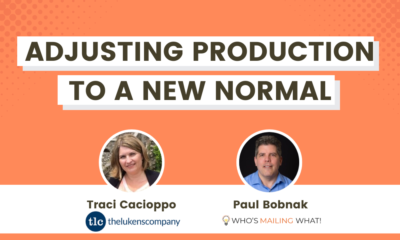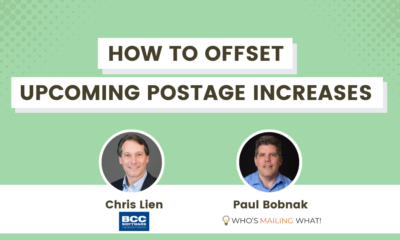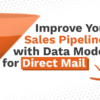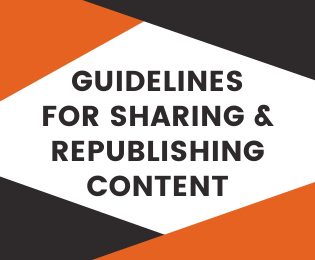MEET THE MAILERS
Meet the Mailers: 2 Keys to Production Success
In this episode, we talked with RWT Production about how the firm works with marketers, nonprofits, and production partners to keep everyone on the same page, literally as well as figuratively.
In this episode, I talked with Jeff Thomas, Director of Business Development, and Cindy Barham, VP, Client Services both of RWT Production, LLC. RWT provides production management services to companies on both sides of the direct mail production process.
We talked a lot about how the firm works with marketers, nonprofits, and production partners to keep everyone on the same page, literally as well as figuratively.
As Jeff put it,
I think the common theme is Plan, Plan, Plan …and depending on who your production partner is – constant communication.
 Jeff ThomasDirector of Business Development
Jeff ThomasDirector of Business Development
RWT Production
Among the many other topics we covered:
- Their backgrounds & day-to-day roles
- How RWT partners with companies
- Best practices for planning a direct mail campaign
- How to control mail costs
- Challenges in planning campaigns across channels
- Industry trends
Here are some questions and answers (edited for clarity and space):
- What are some best practices for planning a direct mail campaign before it even leaves the building?
Jeff: We could probably talk about this for a good few hours. I think the common theme that Cindy and I would probably just repeat ad nauseam is “Plan, Plan, Plan.” And I guess I’d probably even back up prior to that and say, depending on who your production partner is – whether it’s a direct vendor or a management company like us – really, really bringing them in early in the process, constant communication. If you’re dealing directly with a production vendor, I would highly recommend visiting that facility, really seeing what the equipment is, how it runs, and what their processes are. That’s actually something that we recommend for our clients and facilitate that as well …And just really try to understand it from your production partners’ point of view.
I guess back to my Plan, Plan, Plan…Cindy and I always talked about how we’re on kind of the tactical side of things. You know, nonprofits and agencies normally work on creative and strategic and really, I think at that stage, you should really be involved in your production partner.
[W]hile maybe the audience you’re mailing to or the response rate you’re expecting, or if it’s an acquisition or renewal – some of that might not matter to your production partner, but really more info is better than not enough. [T]hat’s key, but I think obviously once the rubber meets the road and you actually have all the creative and strategy figured out … you can really get in the weeds, right? Data management, data processing, where you’re talking about data hygiene, not that I want to go down the rabbit hole of data security… that obviously adds some complication to it, but then, you’re just talking about the processes of NCOA …Are you going to run ACS, PCOA, CASS certification? [O]ne of my sayings, and I know everybody I worked with on the production side got tired of hearing me saying this is: “Proactive rather than reactive.” You’re trying to make sure and avoid any of those pitfalls and mistakes that you’ve made in the past and make sure that everything runs smoothly on time and on budget.- What challenges do you face when coordinating or partnering with strategy firms or agencies, as well as other clients, and even the USPS?
Cindy: I think some of it goes with what Jeff is saying is of making sure that your production partner is part of the plan early enough. So if you’re mailing a small- to middle-range file, you know, our production mail shops have done a great job of investing in technology recently.
Whereas old school … talk about the Cheshire label life, back in the day, you printed the forms with the pins on the side, and you lasered ’em through a laser on the only black ink. Well, these days, mail shops really are investing in how to maximize their profitability. And so by doing that, they’re bringing in digital work, digital printers, print on demand, variable technology.
So by allowing your production partner a glimpse into some of the plans that you’re doing, you can then allow that production person to say, “this is a perfect project to run digital or to print on demand, or we can integrate this into different fields from your data if we know you like dogs, we know you like cats. we know you came into an acquisition package with a widget.”
We can talk about the widget instead of the whirligig. We can talk about the whirligig. And so that’s been really, really great with how invested our partners are with helping, especially us, because we support nonprofits specifically, helping our clients to stay successful.
[C]oordinating and partnering with our agencies is making sure that we’re in the loop early enough, so that we can provide the most efficient way to handle something.And the same thing with USPS. [W]e have relationships with different liaisons at USPS based upon different segments of work. We have a political partner that we work with that helps understand what’s going into the market and the political cycles. We have other business development people. We have people that partner with us specifically on the promotions, design, rates and classification. All of those helps us to kind of make sure that we’re doing what we need to do for our clients and ahead of the game before we submit a mailing and realize that something’s wrong.
Jeff: I think the USPS challenge, that’s an important thing to hit on as well. I mean, obviously they are a very important cog in the process. It might be at the tail end of where you’re injecting this mail into the mail stream, but to have strong relationships and partnerships, they are key.
I can certainly do some USPS bashing for all the years that I’ve dealt with them, cause I think really, probably my biggest frustration was just the inconsistency that you could see from one post office to the next. But that’s definitely improved a ton … I guess ever since they’ve implemented Full Service and Seamless Acceptance, a lot of things that make things more cohesive and consistent across the country.
- So we all know that postage costs and consumables [are] top of mind for a lot of people. What kinds of things can people do to keep their costs under control?
Jeff: Key question, especially in recent years, right? I think probably where I’d hit first is data. And I guess from the planning perspective … I’m talking about, like from the nonprofit point of view, kind of paring down the data you’re selecting for the mailing. Kind of mailing to your best recipients, your best responders. No point in mailing a large list to a lot of people that haven’t responded or given in a long time.
Additionally, on the data side, just making sure that data is data is clean… Back to what I mentioned about all the processes on data – NCOA, PCOA, ACS – making sure that there’s no duplicates … that this mail is going to get to the intended recipient.
Obviously, if you’re mailing a pretty high-touch piece that’s fairly expensive … if you have 300 records in there that are undeliverable, where that’s just trash, it’s wasted money. I guess other than that, obviously, we’ve talked about postal promotions.
I think that’s a no-brainer these days. [USPS] raising rates twice a year now, but at the same time, they’ve continued to roll out new promotions left and right. And so not only do you offset that potential postage rate increase, but you’re looking at an additional touch with things like Informed Delivery and whatnot.
Certainly, we can talk about kind of the rebirth of the QR code, but I mean, there are a lot of promotions there, that again, I think you’re really missing the boat if your vendor partner or your production management partner doesn’t have you enrolled in this.
[O]ther than that, you know, good old gang printing, bulk printing, again, kind of looking at the programs holistically. If a pitfall, definitely some organizations fall into is looking at a job-by-job. To where, you know, especially if they have a robust program that you’re mailing 10, 12+ mailings a year, and you’re using the same #10 envelope, the same BRE, obviously there’s some savings there to print for the entire year rather than job-by-job.But it is still surprising how many organizations get the blinders on [and] kind of look at a job-by-job and go, “Wait a second. You know, I could have saved X amount of dollars throughout the year.”
Cindy’s point about digital printing, I mean, even along the lines of gang printing and how it’s been around forever, digital printing, similarly, right? But I think the technology is just really just kind of [a] rocket booster in the last five years or so, as far as the quality and catching up to offset printing.
But if all of the other components in the package are consistent and the only variable is copy and art, well, then you can combine, let’s say seven segments into one. And obviously, that’s going to save you on production costs and postage.
Cindy: And when you work with a production management firm, I think that one of the things that we do is we try to look at some of those higher-cost items as well. So maybe note cards. If you’re mailing a note card package if you’re mailing a calendar, and we do look across our clients to say, “OK, who’s printing a wall-size calendar throughout the year, let’s see if we can maximize them together, do two, do three, however many runs you can support.” But it does provide some of those smaller clients that may want to do a package with bells and whistles, but just can’t afford it.
But then when you gang them into a 10 million-piece calendar run, their 25,000 calendars … it comes into the cost that they need. So I think that that’s also our responsibility as a production partner to use the leverage of all of our clients to help all of them. RWT does a good job of that.
Jeff: Yeah, I think you can also hit on kind of lessons that we all learned during the pandemic and the supply chain shortages and all that to where obviously you’re looking at different paper stocks, maybe not going with a name brand Husky or, you know, whatever, where there might be a more cost-effective option. [A]lso looking at where, you might be mailing an insert package that could simply go as a self-mailer, just a different format change.
- Let’s talk a little bit about the big vertical market that RWT serves. What are some good practices for nonprofits for their direct mail campaigns?
Cindy: It’s such an interesting question because I think that best practices can mean so many different things to different groups. I grew up in nonprofits thinking that I needed to get it as cost-effective as possible. “We’re going to mail this in black and white. Maybe you can use 1 color on it, but that’s going to be the down-and-dirty cheapest because we want all of our money to go to other program things within our organization.”
That’s maybe not the case these days, so there are a lot of different best practices that are out there.
You can probably tell the theme of this for us is Plan, Plan, Plan. So that would obviously be my top-of-mind, best practices to plan and to bring your production people involved as soon as possible. But, outside of that, a best practice could be “I need to bring in 20,000 new donors this year. So numbers tell me I’m going to work with my list broker. Numbers tell me that mailing a freemium, a full-size wall calendar, notepads, note cards is going to be the way to do that. My goal is to bring in the most amount of revenue, and it doesn’t matter how many new donors come in”. So, that may tell me something else.
[A] lot of it depends upon what your goals are as an organization and you’re sharing those goals out to everybody on your team so that we can all be on the same page. [S]o I would say best practice is communication because going back to what Jeff said about production, we could talk about best practices in production all day – eliminate your bleeds, stick with this – but that’s not necessarily going to accomplish what everybody’s looking for.Jeff: Well, I’m just going to hit on kind of the nonprofit side of it. And kind of what Paul said is, [on the], commercial side, you might be dealing with specific products or services, right? But on nonprofits, you’re talking about causes and missions that, you know, can be drastically different one from the other.
And, you know, we saw it during the pandemic: some nonprofits thrived, and some just got killed. So it just really varies depending on who you’re working with.
- So today we see that direct mail is frequently and maybe not enough integrated with other channels and this creates another challenge for production. What should marketers and brands and nonprofits be doing to ensure that there’s a smooth process that gets all the different channels delivered on time?
Jeff: [Y]ou’ve heard the talk of multichannel and integration, and I guess now it’s omnichannel … but I feel like it’s always been the same thing. [I]n the nonprofit space, I think they’re still… challenges there for them to keep up the pace with commercial and the data that they have. [F]or us, it might be something as simple as like a triggered email, to where we have the mail tracking file so that we share that with their digital team, so that they’re sending emails as the mail is delivered, rather than just doing a generic send of, “oh, it’s been two weeks, let’s just send the entire email file.”
[I]t’s really just kind of another additional deliverable date in the production schedule for the most part. But certainly, I guess I’d go back to Informed Delivery and mail tracking and triggered emails. I mean, that’s really the bulk of what we’re involved with.Cindy: Yeah, just to use the reporting that’s available to you. RWT has a rule that we track 100% of our outbound mail that has an IMb on it … those reports can be generated on a scheduled or a need-to basis, and using those reports then can help you build out a schedule for all those other campaigns. And we have a lot of clients that are requesting those at specific times… They provide a wealth of information. We can track inbound mail now. We can track the metrics for Informed Delivery. If you have a really great partnering tracking firm – which we do, we love our tracking firm – they can provide a lot of information that then can be shared across other teams within an organization.
- So, with your experience, what trends do you see unfolding in direct mail for the next couple of years?
Cindy: I love digital print. I’m going to touch on that and then let Jeff finish up.
But, you know, having come from an old-school mail shop, I love that our vendor partners are investing in moving us forward. And so I really think that using your data to maximize the ability of that digital or print-on-demand is going to be key.
Jeff: Yeah, I would definitely echo that. I think it kind of goes back to what I said before, just how quickly digital printing has advanced in the last handful of years. And, you know, we obviously expect that technology to just keep ratcheting it up year by year.
[T]o piggyback kind of on that last topic we talked about with omnichannel and multichannel, I think that will tie in with digital, right?Being a direct mail nerd, I pay attention to the mail that I get and any supporting digital, you know, efforts that they make, I can count on one hand that, you know, the organizations that are doing it and it’s the big ones, it’s Verizon, it’s the people that have the resources and the bandwidth and the money to be able to do it and do it well.
But certainly on the nonprofit side of things, I think that’s what I see and would love to see where they’re segmenting and really speaking to these donors and being able to have the data to trust and utilize, to build those omnichannel campaigns that are really successful.
Cindy: I mean, it’s generating 60-70% of their fundraising income direct mail still is, you know, and obviously digital is growing, but there are so many things that are involved in the digital space now that it’s interesting.
I would also say that one of the things that I think that we’re seeing – to go back to the initial point I made earlier – is that working with a production management firm that really understands the full picture, so because RWT hires high-level people that have come either from a printer or a mail shop or an agency, so they have full knowledge of what these organizations are going through.
I’ve seen more reliance on our staff within the last five to eight years to kind of help with driving creative or not strategy per se, but helping understand what the production team can do for them.
And so that alliance seems to be a little bit heavier on our staff now than it was 10 to 15 years ago when we really just were turn and burn. So that has been, I think our staff has risen to the occasion for that. And so it’s fun to see everybody get excited about their clients!
Here is our conversation (with all questions and answers). We’ve added timecodes for your convenience.
Thank you, Cindy and Jeff, for sharing your perspective and your expertise! To learn more about RWT, visit their website at www.RWTProduction.com.
Your comments and ideas are very important to us in making your Who’s Mailing What! experience even better for you. Through these engaging talks, we hope you’ll take away practical tips, insights, and personal stories to inspire and build your own success.
If you have any feedback — or are interested in sharing your expertise and viewpoint with our wide and diverse audience on “Meet the Mailers” — please reach out to me. I’d love to hear from you!






















